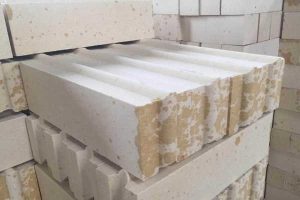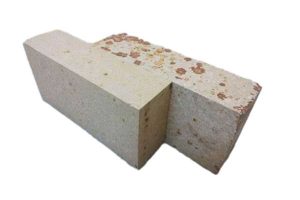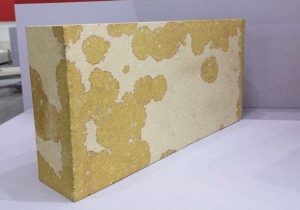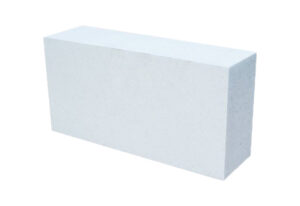Siliciaj Brikoj por Vitraj Fornoj
Silicon bricks are widely used in glass kilns, and their main component is silicon dioxide (SiO2). Silica bricks used in glass kilns require SiO2 content above 94%, high use temperature between 1600~1650℃, and density between 8~95g/cm3.
The porosity requirement is less than 22%, the larger the porosity, the worse the quality of the silicon brick.
The appearance of silica brick is mostly white crystal, the microscopic composition of scale quartz crystal because the silica brick at high temperatures will occur crystal transformation, and volume expansion, especially at 180 ~ 270 ℃ and 573 ℃, crystal transformation is more intense.
Tial, the baking kiln and cold repair process should adapt to the crystal transformation of silicon firebrick, such as loosening and tightening the pulling strip. The silica brick masonry should be left with expansion joints.
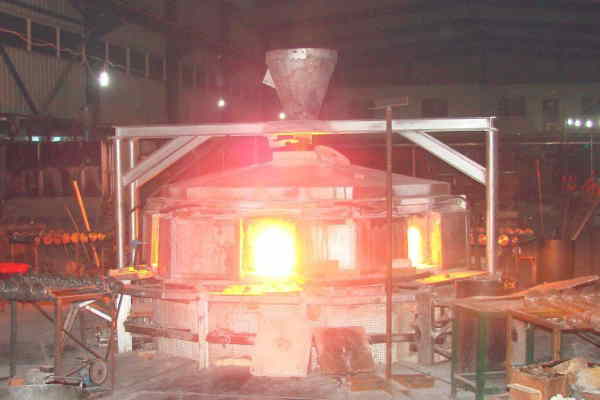
The working temperature of silica brick in a glass kiln is about 200℃ higher than that of clay brick.
Tamen, because of the poor erosion resistance of glass liquid and alkaline flying material.
It is used for constructing large abrasive wheels, chest walls and small furnaces, and other structures.
When constructing, bonding materials are made with substances close to the composition of silica bricks such as high-silica refractory clay and silica brick powder.
The composition of silica bricks (w) is 45% square quartz, 50% scaled quartz, 1% al 2% glass phase, a small amount of residual quartz, and a fusion index (2R2O + Al2O3) <0.5%.
After the glass kiln adopts oxyfuel technology, the life of silica bricks is drastically reduced from 5~10 years to 2~3 years.
Lattice Silica Bricks for Hot Blast Furnace
Changes in the denseness and phase composition of refractory bricks affect their quality and heat capacity.
After the use of a hot blast furnace, the test results of lattice silica bricks show that.
1. The porosity of lattice silica bricks is 18%, bulk density is 88%, Al2O3 content increases to 2.83% (mass fraction), CaO content is the level of the original refractory bricks (43% (mass fraction), other impurities content is very low.
2. Except for the transformation of the silica brick skin from squamous quartz to square quartz, the rest of the brick consisted of squamous quartz and a small amount of silicate.
3. No distortion of lattice silica brick was found after use, such as distortion, which shows that the quality and heat capacity of lattice silica brick in a hot air furnace will not change significantly. Tial, it is presumed that the heat capacity of lattice silicon brick will not be reduced.
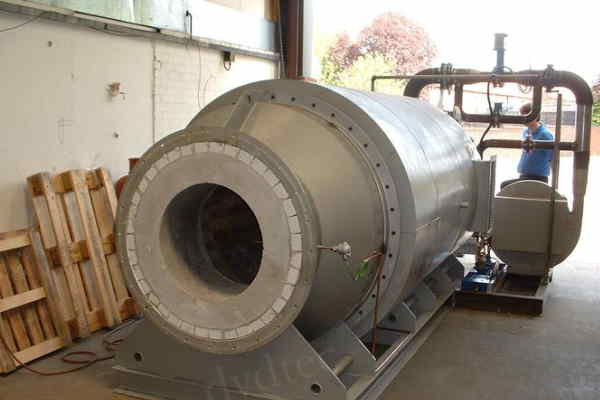
Performance Characteristics of Hot Blast Furnace Silica Bricks
Silicon bricks for hot blast furnaces are silicon refractory products with scaled quartz as the main crystalline phase, which is used in the high-temperature part of the blast furnace. Hot blast furnace silicon bricks should have the following characteristics.
1. Stable volume and low creep rate at high temperature under long-term high temperature and load conditions.
2. 600 degrees above the thermal shock resistance, can adapt to the hot blast furnace temperature changes, to maintain the integrity of the brickwork.
3. Good chemical resistance.
4. Large thermal conductivity.
According to the metallurgical standard (YB/T133-1998), the silicon brick for a hot blast furnace is designated as RG-95, which is divided into the roof, wall brick, and lattice brick according to the usage.
Coke Oven Silica Bricks
Silica bricks for coke ovens are silica refractory products used for building coke ovens with scaled quartz as the main crystalline phase.
Modern coke ovens are large thermal equipment made of tens of thousands of tons and nearly a thousand types of brick refractories, of which silica bricks account for 60% al 70% of the usage.
It is used to build coke oven heat storage chamber walls, ramps, combustion chambers, charring chambers, tegmentoj, ktp.
Traditional coke oven silica bricks have good chemical stability.
If we can keep the anisotropic performance of traditional coke oven silica bricks and improve the thermal conductivity, we can ensure the unity of structure and stability of the material.
Tial, high thermal conductivity silica brick is a product that meets the requirements of coke oven development.
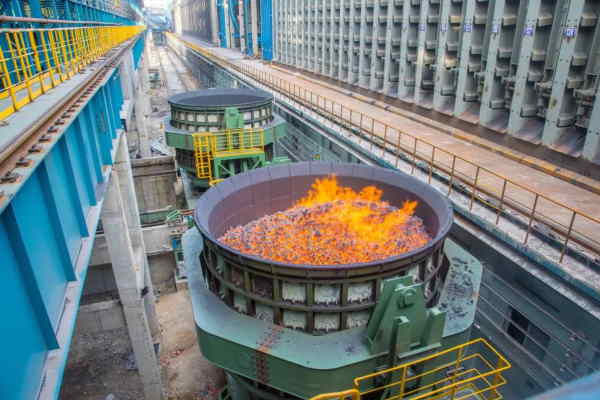
Coke oven silicon brick should have the following characteristics.
1. High Load Softening Temperature
Coke oven silica bricks should bear the dynamic load of a coal loading car at the top of the furnace at high temperature, and require long-term use without deformation, so a high load softening temperature is required.
2. High Thermal Conductivity
Coke is made from coking coal heated by conduction in the charring chamber through the walls of the combustion chamber, so the silica bricks used to build the walls of the combustion chamber should have high thermal conductivity.
3. Good Thermal Shock Resistance
As the coke oven should be loaded with coal and coke regularly, the temperature of the silicon bricks on both sides of the combustion chamber walls should change drastically, so the coke oven silicon bricks should have good thermal shock resistance.
Coke oven silica bricks have high SiO2 content, high compressive strength, alta ŝarĝo mildiga temperaturo, low residual should-time content, and good wear resistance.
After testing and identification, the main performance index of the product has passed and reached the standards of Japan SC, Germany DIN, and Japan MS.
The product is characterized by high purity, alta forto, wear resistance and denseness, high thermal shock stability, volume stability, and low creep after use. The product is widely used in 4.3m coke ovens, 5.5m coke ovens, 6m coke ovens, and 7m coke ovens.
Resumo
Entute, while silica bricks used in glass kilns, hot air furnaces, and coke ovens share some similarities in terms of their composition and manufacturing, there are also some important differences in the way they are designed and used in each application.

